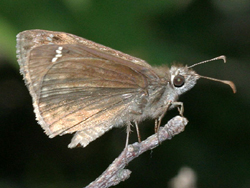Find a Butterfly
Horace's Duskywing
Erynnis horatius
Named
Scudder and Burgess, 1870

Identification
Wingspan 1 1/4 - 1 3/4", mostly over 1 1/2". Only Juvenal‘s Duskywing is as large as this species, and this characteristic alone will serve to distinguish it from the smaller species, once the observer gains some experience with several species of duskywings. Furthermore, since Juvenal‘s rarely flies after early June, any large summer Erynnis can be assumed to be this species. For confirmation (or in the spring when both large species are on the wing) look for the pale dots near the outer edge of the hind wing below, which are unique to juvenalis. Viewed from above, the spring brood Horace‘s males are too similar to Juvenal‘s to allow separation, but the females have the black areas more contrasting on average, and can often be tentatively recognized this way. In addition to its larger size, Horace‘s may be distinguished from Wild Indigo Duskywing by the lack of any hint of the paler brown forewing patch typical of the former. Note that spring Horace‘s will be flying in company with Juvenal‘s Duskywings, which probably causes Horace‘s to be overlooked frequently. The male genetalia are distinctive.
Distribution
Throughout the eastern United States east of the Great Plains from northwestern Minnesota to the coast of southern New England south to Texas and Florida; also a disjunct population cluster to the southwest. Not recorded from Canada. This is a very common duskywing in the south, its distribution becoming more spotty north of New Jersey. In New England, it reaches its northern limit in extreme southern New Hampshire (Schweitzer, pers. obs.).
Status in Massachusetts
Frequent to common in the Boston area, and probably also in the southeastern counties, during the mid- to late 1980‘s. Previously apparently less common, but old records show a distribution similar to the current one. Atlas records extend only as far west as Worcester County, but suggest that the species is widespread eastward. The MCZ has old specimens from Montague (Franklin Co.) and Granby (Hampshire Co.) and Scudder (1889) records the species from Amherst. In summary Horace‘s Dusky Wing can be locally common if sought at the right time and place. Middlesex Fells (Winchester?, Middlesex Co.) is a good place to see this species.

Flight Period in Massachusetts
Two flights with with most Atlas records from mid- to late May and late July to early August with none from 8 June through 9 July between the two main broods. Extreme dates: 27 April 1949, Waltham (Middlesex Co.), D. Lenox, and 20 September 1936, Westport (Bristol Co.), D. Lenox; the September record represents a partial third brood.
Larval Food Plants
Oaks. In Massachusetts females oviposit on sprouts of White Oak (Quercus alba) at Middlesex Fells (Schweitzer, pers obs.). Also recorded from Scrub Oak (Q. ilicifolia), Red Oak (Q. rubra), Black Oak (Q. velutina) and Post Oak (Q. stellata), all of which occur in Massachusetts.
Adult Food sources
Found on eleven species of wildflowers during the Atlas period. In New Jersey adults very commonly come to flower gardens.

Habitat
Dry, rather open, rocky or sandy oak woods and pine barrens. Often along paths and powerlines, but can be found back in the woods where the canopy remains open. Summer adults venture out into fields, waste places, and roadsides in search of nectar.
Life Cycle
Two well defined broods (See flight periods, above). EGG: No information. Presumably like other duskywing eggs, i.e. pale green turning reddish brown; a hemispherical dome with prominent vertical ribs and finer raised lines running horizontally between the ribbing. OVIPOSITION: Eggs are laid on the underside of leaves; south of New England, horatius prefers to oviposit on small oaks, even seedlings. LARVA: Stout, tapering to both ends; green with a dense covering of yellowish points giving an overall yellowish color and "mealy" texture; a darker green stripe down the back and a yellow side stripe; covered densely overall with fine short hairs; head black with patches of dull yellow. The larva makes the typical duskywing nest by folding a leaf and securing it with silk. CHRYSALIS: Whitish green thorax and end of the abdomen, otherwise yellowish green with a "prominent velvety black raised dot" (Scudder, 1889) at the base of the wings. PUPAL STAGE: The spring brood caterpillars probably leave their last feeding nest and make a cocoon in which to pupate in the leaf litter, emerging in two to three weeks; the hibernating brood leaves its winter nest (which may be made on the host tree and drop with the leaves) and makes a new nest in which to pupate in the early spring. OVERWINTERING STAGE: Full grown larva.
Adult males often defend a territory and perch on a projecting twig or plant stem.
This account was contributed by Dr. Dale Schweitzer, Invertebrate Zoologist, Eastern Heritage Task force/The Nature Conservancy.

